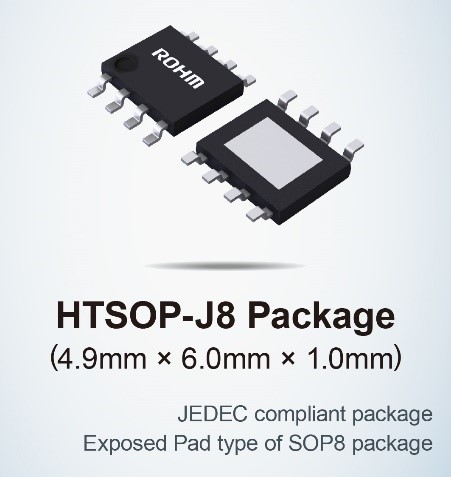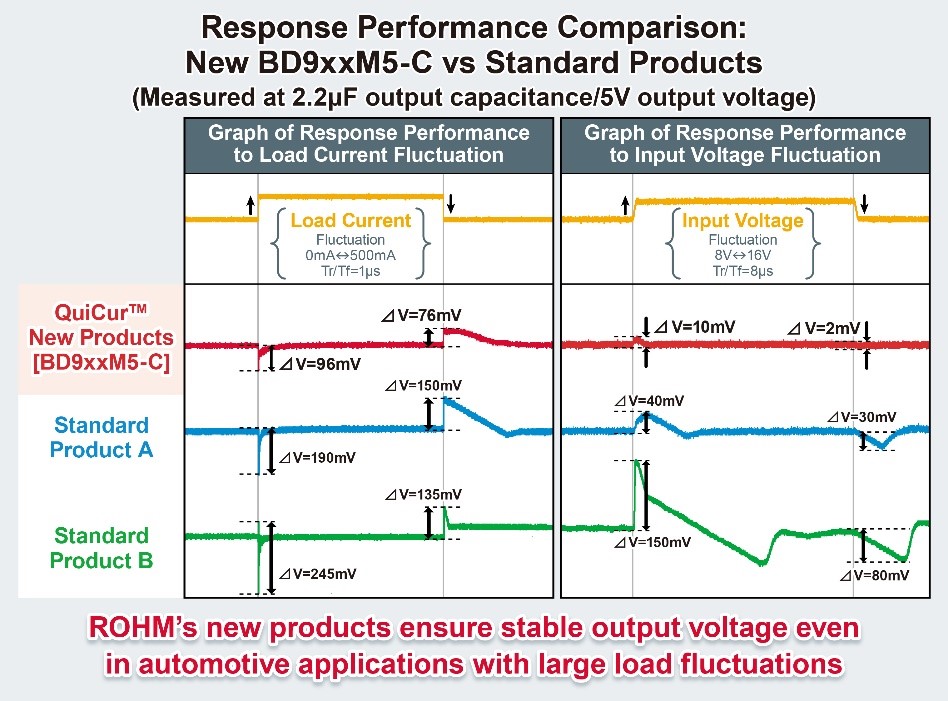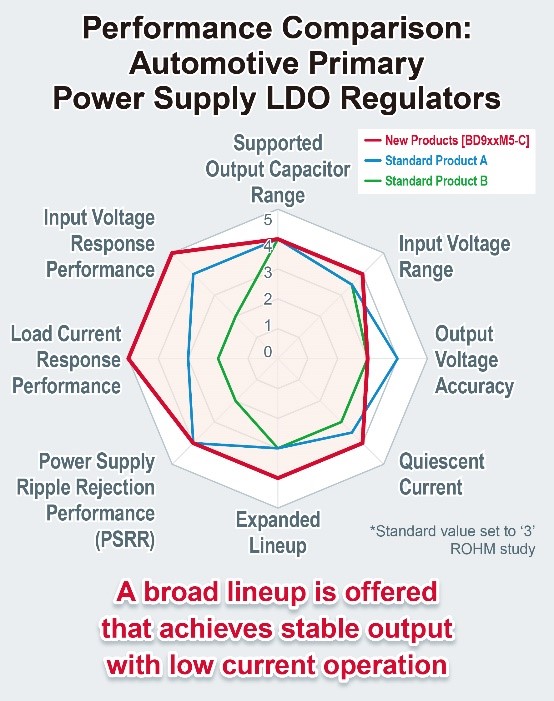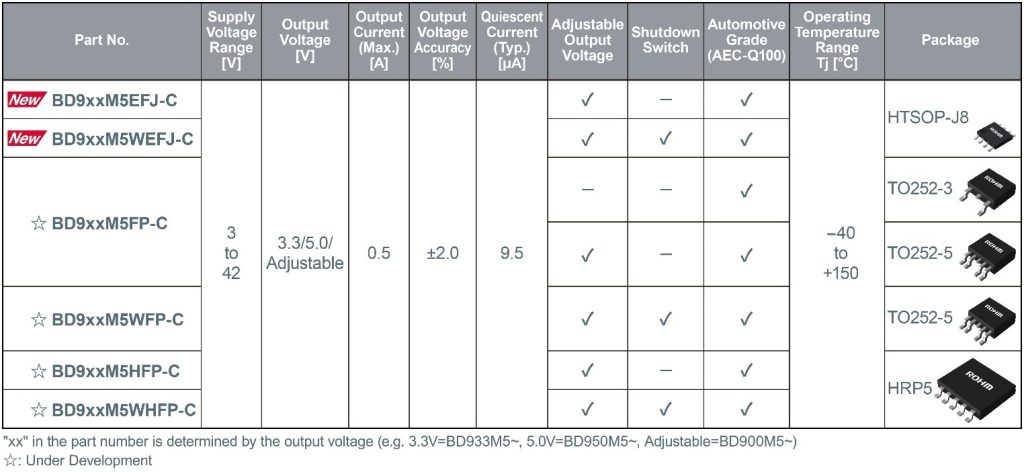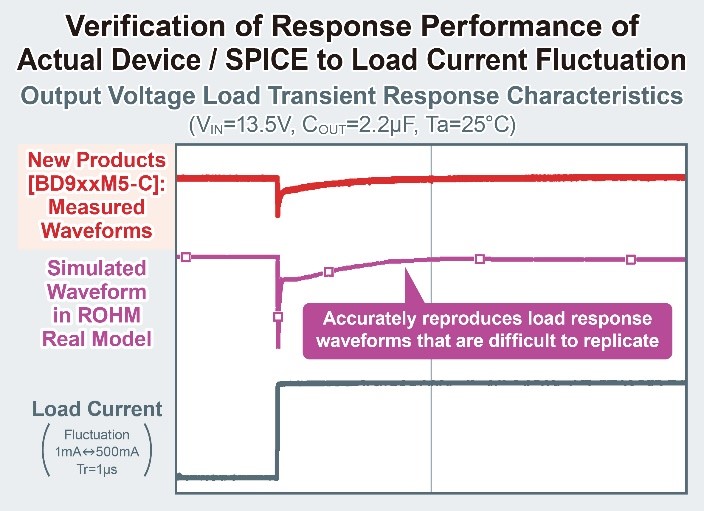Ensures stable output in automotive applications with high input voltage and significant load jumps
ROHM has developed 45V rated 500mA output primary LDO regulators: BD9xxM5-C (BD933M5EFJ-C / BD950M5EFJ-C / BD900M5EFJ-C / BD933M5WEFJ-C / BD950M5WEFJ-C / BD900M5WEFJ-C). These devices are suitable for supplying power to automotive electronic components such as ECUs that operate from vehicle batteries.
In recent years, the number of onboard power supply systems and functions continues to grow as electrification in the automotive industry progresses. This increases the demand for primary LDOs that can directly step down the battery voltage to MCUs and other components used in ECUs. However, the energy supplied by the vehicle’s lead-acid battery is often subject to sudden voltage fluctuations, which primary LDOs are required to provide with excellent line-transient response in these conditions.
At the same time, ECUs and other downstream devices often experience load current variations during operation, which also demand excellent load-transient response characteristics. A high-frequency response is essential for fast output voltage recovery, but it has been difficult to provide sufficient phase margin at the same time to ensure stable operation. In response, ROHM developed a novel solution that addresses these challenges.
The BD9xxM5-C incorporates original QuiCur high-speed load response technology that delivers excellent response characteristics to load current fluctuations. For example, the LDO can maintain output to within 100mV of the set voltage even as the load changes between 0 and 500mA in 1μs (Rise time/Fall time). Furthermore, low 9.5µA (typ.) current consumption contributes to lower power consumption in automotive applications. These new products will be available in four packages, ranging from the compact HTSOP-J8 to the high heat dissipation TO252 (TO252-3/TO252-5) and HRP5 types. This allows users to select the most suitable package for each use case.
Going forward, ROHM will continue to improve reliability while reducing power consumption in automotive applications by developing products utilizing its strengths in analogue and other technologies.
Product Lineup
The new BD9xxM5-C meets the basic requirements for automotive products, including 150°C operation and qualification under the AEC-Q100 automotive reliability standard. A wide range of packages will be available to select from depending on the application environment, all featuring excellent response performance and low current consumption using proprietary QuiCur technology.
The lineup will be expanded to comprise a total of 18 models, (including the TO252-3, TO252-5, and HRP5 packages) by FY2024.
Application Examples
Suitable for a wide range of automotive applications such as ECUs that operate on vehicle primary power supply systems.
- Powertrain: Fuel Injection (FI), Tire Pressure Monitoring System (TPMS)
- Body Systems: Body Control Modules
- Infotainment: Instrument Clusters, Head-Up Displays (HUDs)
QuiCur High-Speed Load Response Technology
QuiCur is the name of ROHM’s proprietary ‘Quick Current’ high-speed load response circuit capable of maximizing load response characteristics (response performance) without causing instability in the feedback circuits of power supply ICs.
Stable operation of the power supply IC is also possible with minimal output capacitance. And in the case of switching regulators, which are a type of power supply IC, it is possible to linearly adjust the capacitance and output voltage fluctuation to easily achieve stable operation even when the capacitance is changed due to specification changes, significantly reducing the number of person-hours required for power circuit design – both in terms of decreasing component count and ensuring stable operation.
Support Tools
ROHM Real Models are high-accuracy SPICE models that utilize original model-based technology to faithfully reproduce the electrical and temperature characteristics of the actual IC, resulting in a perfect match between the IC and simulation values. This ensures reliable verification, contributing to more efficient application development – for example by preventing rework after prototyping.
Terminology
Primary
In a power supply circuit, the side in charge of 1st stage conversion from a power source such as a battery is called the primary and the side responsible for 2nd stage conversion is referred to as the secondary.
LDO Regulator (Low Drop Out/Low Saturation Regulator)
A type of power supply IC that converts between two different DC voltage levels. Falls under the category of linear regulator (where the input/output voltages operate linearly) characterized by a small input-output voltage difference. Compared to DC-DC converter ICs (switching regulators), LDOs feature a simpler circuit configuration and lower noise.
Load Current
From the point of view of the power supply ICs, all electronic circuits in the subsequent stages, including MCUs and sensors, can be considered “loads”. When these loads operate, a (load) current flows, causing the output voltage of the power supply IC to undershoot (drop) or overshoot. Load transient response characteristics refer to the response time until the changed voltage due to the load current is restored and the power supply stabilizes.



